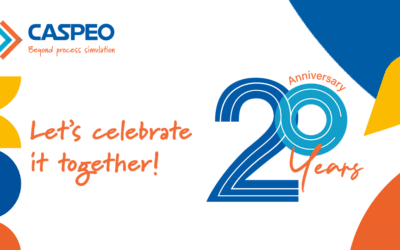Mineral processing simulation, a new step of the simulation-based approach: the supervisor
Back to the future – Paper presented at IMPC 1995 congress in San Francisco – It describes the new level of simulation implemented in USIM PAC simulator 30 years ago: the supervisor. A simulation tool use now commonly for decision making purpose and for evaluating the confidence level of the predictions. A new kind of mineral processing simulation tool… for 30 years already!
A step further to meet the mining engineer process optimization needs…
For the design or the optimization of a mineral processing plant, the use of a steady-state simulation approach is now recognized to be a real help for the process engineer. Several hundreds of copies of simulation packages are in use in the industry in mining and mineral processing groups, in manufacturers or engineering companies, in research centers or universities.
The capabilities of these software are different in terms of quantity and quality of mathematical models imbedded, in terms of spread of the field of applications or in terms of easiness of the interface but most of them are improving continuously to offer the biggest help for the user. These improvements may cover all the steps of the simulation-based approach such as sampling, data reconciliation, modelling, simulation algorithms or cost calculations.
The simulation-based approach along the mineral value chain
Simulation of mineral processes is now commonly used by the engineers in charge of plant design or optimization but a good knowledge of the simulation tool is still needed to conduct a project. A new level of algorithm has been defined above the simulator to answer directly to the user’s questions.
This level has been called the supervisor of simulation, which is using the automation concepts of sensors and actuators. At any place of the flowsheet (i.e., a stream or an equipment), the user may indicate which value could change by graphically implementing an actuator. Then, he can evaluate the effect of the variation of this value at any other place of the flowsheet by inserting a sensor. Thus, by example, it becomes possible to look at the evolution of the recoveries and/or the circulating loads when scanning an interval of the possible feed flowrates.
This approach conducts to an increased facility in using a process simulator and in analyzing the predictions. It is also a very valuable tool for permitting to characterize the sensibility of the simulation results to the variation of some settings (e.g., load of grinding media, rotation speed, water addition, etc.) or feed characteristics (e.g., flowrate, sizes, grades, grindability, etc.). Thus, the most important variables can be identified for design and pre-control optimization of plants.

Simulation-based optimization approach
Use of USIM PAC process simulator for decision making purpose
The focus of this paper is to highlight one of the step of this approach which is the closest to the user objectives i.e. the use of the mineral process simulation tools for decision making purpose and to evaluate the confidence level of the predictions. A new level of algorithms has been defined, above the simulation per se, to control the effect of some variables on the performances of processing circuit.
In this paper, three examples are presented:
- The first one shows in an existing copper grinding flotation circuit the way to automatically control the effect of a variation in the feed rate to the mill on the recovery and grade of the flotation concentrate.
- The second illustrates the analysis of the sensitivity of a grinding circuit on the possible variation of the grindability of the ore at the design stage.
- The third presents the application of this algorithm for the sensitivity analysis of the models used for optimization. This application illustrates the advanced use of the supervisor to improve the calibration of a mathematical model and thus improve the further predictions of the simulator.
Abstract of the paper presented at IMPC 1995 – XIX International Mineral Processing Congress – San Fancisco
Authors:
- Jean-Claude Guillaneau, BRGM
- Jacques Villeneuve, BRGM
- Stéphane Brochot, CASPEO
- Marie-Véronique Durance, CASPEO
- Guy Fourniguet, BRGM
Discover USIM PAC software for mineral processing simulation
USIM PAC is the only process simulator on the market able to model in one platform nearly all the mineral processing value chain starting from crushing to refining progressing through grinding, separation, flotation, leaching and concentration. Initially developed for mineral processing and hydrometallurgy 30 years ago, USIM PAC flexible structure has been allowing to approach all industries processing natural, variable and heterogeneous materials.
Recent posts
CASPEO is proud to announce the launch of CASPEO DAYS 2024, a conference dedicated to exploring the future of mining
CASPEO DAYS 2024 will explore the pivotal role of data reconciliation. It will be focused on the data quality and how to achieve it… On the Path Towards Intelligent Mining!
CASPEO celebrates its 20th anniversary in 2024
This year, CASPEO is celebrating its 20th anniversary, marking two incredible decades of innovation, growth, and success in the mining industry. A celebration marked by a conference "On the path...
Master II Internship – Modeling of hydrometallurgical operations: solvent extraction
CASPEO develops and distributes the USIM PAC software, a static process simulator for the design and optimization of mineral processing and hydrometallurgical plants. Hydrometallurgical operations...
Subscribe to our newsletter
Ready to talk about your project?
Question about your process, our process simulation software or services? Write us here to be in touch.
CASPEO provides trusted process design and optimization services and simulation software to engineers dealing with solids and all types of raw materials. With CASPEO, go beyond process simulation.
Stay tuned!
Empower your decisions
Consulting
Engineering software
Get a quote
Develop your skills
Blog
Get a live demo
Need assistance?
On-line support
Contact us
2024 © CASPEO - All rights reserved




